Stonehenge is a prehistoric monument located in southeast England, near the city of Salisbury. It is a globally famous, UNESCO World Heritage Site.
For both professors this is literally a once in a lifetime opportunity. Said Darvill, of the University of Bournemouth: "It is an incredibly exciting moment and a great privilege to be able to excavate inside Stonehenge."

|
| ©Frederic Vincent |
Experts date the earliest construction on the site to be 5,000 years ago. This consisted of earthen works and timber structures. Two concentric circles of bluestones were erected on the site around 2600 B.C. These were transported from Preseli, 153 miles away in south Wales. Two-hundred years later the bluestones were removed and the iconic standing stones, each weighing around 25 tons, were erected. The bluestones were later re-erected at the site. The main objective of the dig is to date the first erection of the bluestones.
Darvill said, "This excavation is the first opportunity in nearly half a century to bring the power of modern scientific archaeology to bear on a problem that has taxed the minds of travelers, antiquaries, and archaeologists since medieval times -- just why were the bluestones so important and powerful to have warranted our ancestors to make the gargantuan journey to bring them to Salisbury Plain?"
Wainwright, president of the Society of Antiquaries, predicted the excavation would shed light on the society that undertook the construction of Stonehenge. He said, "This dig will help us to set the first Stonehenge in its social and economic framework."
A Place of Healing or Dying?
Stonehenge was constructed by a culture that left no written records. So many aspects of the monument are still debated. Several theories have been put forward as to why such a huge effort was put into the construction of Stonehenge. The most popular theory is that it was an ancient astronomical observatory. However, Wainwright and Darvill have another theory.
They recently pinpointed the exact location in Wales where the bluestones were quarried. In this region bluestones are reputed to have healing powers. The team believes it is this magic healing power that lay behind the transporting and erecting of the bluestones to create a "Neolithic Lourdes." This theory appears to be supported by the growing body of evidence of sickness and injury on human remains excavated around the site.
Wainwright said, "We have our fingertips on the answer to the eternal question of why Stonehenge was built."
This excavation, which has been blessed by local druids, will last for two weeks. The BBC, which is partly funding the excavation, has daily updates on the dig at Timewatch.
Stonehenge is maintained by English Heritage. It is open to visitors, who are currently able to watch live video coverage of the excavation.



Reader Comments
to our Newsletter